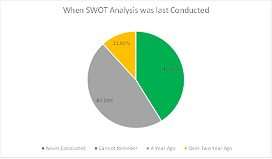The Importance of Business Environmental Analysis: A Case Study of Zambian Breweries

Abstract:
This study’s main purpose was to assess how well Zambian Breweries analysed
business performance using SWOT (Strengths, Weaknesses, Opportunities, and Threats)
and PESTLE (Political, Economic, Social, Technological, Legal, and Environmental)
analytical approaches. The methodology involved the distribution of a survey through
the Google Forms platform, to which 17 respondents answered, and the collection
of data utilising that survey. The results of the study were generated by the Google
platforms based on the respondents’ responses. According to the study’s findings,
Zambian Breweries occasionally performed SWOT and PESTLE analyses to assess the
internal and external environments of the business and to assist in decision-making.
The study further shows that managers at Zambian Breweries use SWOT and PESTLE analyses
to weigh the advantages and disadvantages of significant choices. SWOT and PESTLE
assessments can be employed for both large and small projects, to make decisions
on marketing campaigns, organisational changes, the adoption of new production methods,
and the introduction of new products. The analysis phase involves gathering employee
viewpoints, which enhances project understanding, acceptance, and execution. To
understand how a company is operating, it is essential to understand its SWOT and
PESTLE analyses. In order to build strategic strategies, businesses must perform
comprehensive study, which calls for the SWOT and PESTLE studies. An internal environment
study and competitive advantage identification are common goals of a SWOT analysis.
PESTLE analysis can be used to look at the external factors that affect the business
environment.
References:
[1] Breweries Shareholders Disposal Circular 2018.
https://www.pangaea.co.zm/wpcontent/uploads/2018/07/Zambrew-Cat-1-Disposal accessed
on 14 June 2020.
[2] Diggers Reporter (2020). Zambian Breweries posts
K15.5m losses in 6 months. https://diggers.news/business/2020/09/10/zambian-breweries-posts-k15-5m-losses-in-6-months/
accessed on 14 June 2020.
[3] Tanya, Sammut-Bonnici. (2015). Strategic Drift.
https://www.researchgate.net/publication/272184191.
[4] Thompson Jr., A., Strickland III, A. J. and
Gamble J. E. (2007) Crafting and Executing Strategy. 15th Edition, New York: McGraw-Hill
Irwin.
[5] Eden C., and Ackermann F., (1998). Making Strategy:
The Journey of Strategic Management Journal of Operational Research, Elsevier, vol. 176(2), 1294-1297.
[6] Beckman, S. L., and Rosenfield D. B., (2008).
Operations Strategy: Competing in the 21st Century. New York: McGraw-Hill Irwin.
[7] Mintzberg H., Ahlstrand, B., and Lampel, J.
(1998). Strategy Safari: A Guided Tour through the Wilds of Strategic Management.
New York: The Press.
[8] Hooley, G., Piercy, N.F., Nicoulaud, B., Rudd,
J.M. (2017). Marketing Strategy & Competitive Positioning, (6th Ed). Harlow:
Pearson Education Ltd.
[9] Blowfield, M., Murray, A. (2014). Corporate
Responsibility, 3rd Edition. Oxford University Press.
[10] Rumelt, R. (2012). Good Strategy, Bad Strategy:
The Difference and Why It Matters. London: Profile Books Ltd.
[11] Mazzei, M. J., and D. Noble (2017). Big data
dreams: a framework for corporate strategy. Business Horizons, vol. 60, No. 3, 405–414.
[12] Johnson, G., Whittington, R., Scholes, K., Angwin,
D., Regnér, P. (2015). Fundamentals of Strategy, (3rd Ed). Harlow: Pearson Education
Ltd.
[13] Jenkins, M., Ambrosini, V., Collier, N., (2016).
Advanced Strategic Management: A multi-perspective approach, (3rd Ed). London: Palgrave.
[14] Grant, R.M., Jordan, J. (2012). Foundations
of Strategy. Chichester: John Wiley & Sons Ltd.
[15] Wall, S., Minocha, S., Rees, B. (2010). International
Business, 3rd Edition. Harlow: Pearson Education Ltd.
[16] Sitkin, A., Bowen, N. (2010). International
Business: Challenges & Choices. Oxford: Oxford University Press.
[17] Porter, M.E. (2004). Competitive Advantage:
Creating and Sustaining Superior Performance. New York: Free Press Inc.
[18] Kelley, K. (2022). What is Data Analysis? Methods,
Process and Types Explained https://www.simplilearn.com/data-analysis-methods-process-types-article,
accessed 4 February 2023.
[19] Wikipedia, Zambian Breweries, https://en.wikipedia.org/wiki/zambian_breweries,
accessed 7 February 2023.
[20] Kuter, U. and Tilmaz, C. (2001). Survey methods:
Questionnaires and Interviews. Retrieved from: http://www.umd.edu.html. (2014, August.
20).
[21] Kirakowski, J (1998). Questionnaires in Usability
engineering http://www.ucc.ie/hfrg/resources/qfaq1.html, accessed 30 April 2023.
[22] Pavline V. Young (1984). Scientific Social Surveys
& Research, Prentic, Hall of India Private Ltd.
[23] Zambian Breweries Annual Report 2019. https://africanfinancials.com/document/zm-zambrw-2019-ar-00/,
accessed 20 March 2023.
[24] Clinton, B. (2009). Harvard Business Review.
Available at: https://hbr.org/2009/09/creating-value-in-an-economiccrisis, accessed
29 January 2023.
[25] IDE-JETRO, Zambian Breweries. Institute of Developing
Economies Japan External Trade Organization. https://www.ide.go.jp/English/Data/Africa_file/Company/zambia02.html,
accessed 30 January 2023.
[26] Ahsan Ali Shaw (2023). Importance of pestle
analysis, uses, advantages and disadvantages. Business Management and Marketing.
https://swotandpestleanalysis.com/importance-of-pestle-analysis-uses-advantages-disadvantages/,
accessed 3 February 2023.
[27] Zambia Country Commercial Guide (2022). Market
Challenges. International Trade Administration, USA. https://www.trade.gov/country-commercial-guides/zambia-market-challenges,
accessed 4 February 2023.
[28] Afrina, A (2022). How the Russia-Ukraine war
affects us. https://university.taylors.edu.my/en/campus-life/news-and-events/news/how-the-russia-ukraine-war-affects-us.html,
accessed 7 February 2023.

